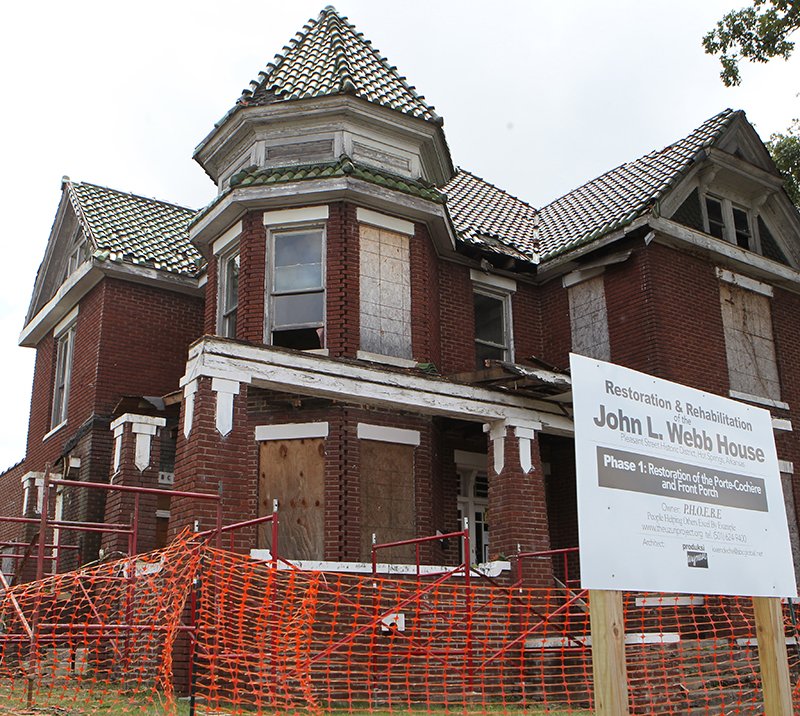The campaign to save and restore the former home of John Lee Webb is picking up steam despite some minor snags, like a flea invasion and increased humidity that slowed the efforts of the workers who began demolition of the porch and porte cochere this week.
"It's a lot of work and it's going to take a lot of time," Cheryl L. Batts, president and founder of P.H.O.E.B.E., (People Helping Others Excel by Example), which is spearheading the project, said Thursday. "God is teaching me patience because I was ready to roll, but you can't just slap it together."
Phase one of the three-phase, three-year project to restore the house, located at 403 Pleasant St., is well underway, with workers removing all the rotting wooden portions of the porch and porte cochere while leaving the brick portions, to give the house "a face-lift."
Batts said they completed work on the porte cochere by Friday and expected the porch to be finished by next week, noting, "so the historic house stands in grand elegance waiting for its new roof with the same historic look."
"They took a lot of photos so they know all the angles and how it looked before so they can rebuild it," Batts said, noting the wooden crossbeams had to be cut and carefully removed. "If you just pull them out you risk damaging the brick."
Once the wooden portions of the porte cochere facing Grove Street and the porch that wraps around the house and faces Pleasant Street are removed workers will also be able to get to the upper windows to begin restoration, "especially the ones that circle around the house," she said.
"You couldn't set foot on the wooden portions facing the windows before, they were so rotted," she said, noting the porch and windows were the major part of phase one.
"I am so excited about this. We will be able to salvage most of the original glass in the windows which is important from a historical perspective," she said.
On Thursday, Batts also finalized receipt of another grant, a $52,000 Historic Preservation Restoration grant from the Arkansas Historic Preservation Program. "It's a matching grant so we put up $26,000 and they put up $26,000," she said, with the money earmarked for the restoration of the iconic green tile roof.
"Phase three will be the roof," Batts said. "That's the biggie."
They should know by September if they will receive another $50,000 grant through the Community Development Block Grant program.
She said Tony Usdrowski is the project's supervising contractor and is a preservation carpenter who specializes in restoring historic buildings and has worked on numerous other local projects. She said he was recommended by Taylor & Kempkes Architects, and noted that he and all his workers are local.
"So we get to keep the money here in Hot Springs which is what I wanted," she said. "I'm just glad to be surrounded by professionals who know what they're doing."
David Reagan, project manager, said, "The project has just started moving along. As soon as the demolition phase is complete, we can get into the rebuilding phase. That will move a little slower, but we'll see some pretty immediate results in the next month as the porch is being rebuilt."
Batts said they got an exterminator to come in Wednesday and completely "de-fleaed" the house. "They had invaded the entire house and were moving into the yard," she said, noting she blamed it on some raccoons in the area.
She said she and Kwendoche, a Little Rock-based preservation architect who is also being consulted on the house, were meeting with the Arkansas Heritage Department in Little Rock Thursday "getting training on how to administer the grant funds."
Batts launched a fundraising campaign last year to save the house, which was built around 1900, and is located in the middle of the Pleasant Street Historic District, which is the largest African-American district in Arkansas. The house is just a few blocks from the Webb Community Center, which was donated by Webb in 1945 and named for Emma Elease Webb, his only daughter, after her death.
The goal for the Webb house is to restore the exterior to its appearance in 1926 and transform the interior into a community resource center and museum of local African-American history.
A native of Alabama, Webb was a builder and contractor and the Supreme Custodian of the Supreme Lodge of the Woodmen of the Union, an African-American fraternal organization established in Mississippi around 1903 and later headquartered in Hot Springs. The Webbs moved here in 1918.
Working with Walter T. Bailey, renowned as one of the nation's best black architects, Webb built the five-story Woodmen of the Union Building, now known as the National Baptist Hotel, on Malvern Avenue in 1923, and it soon became the center of African-American culture in Hot Springs.
Organizers are planning two fundraising events, which will prove to be creative, innovative and necessary for the continued restoration of the house, Batts said. For more information about the house, or to donate, call 624-9400 or visit http://www.theuzuriproject.org.
Local on 06/26/2016